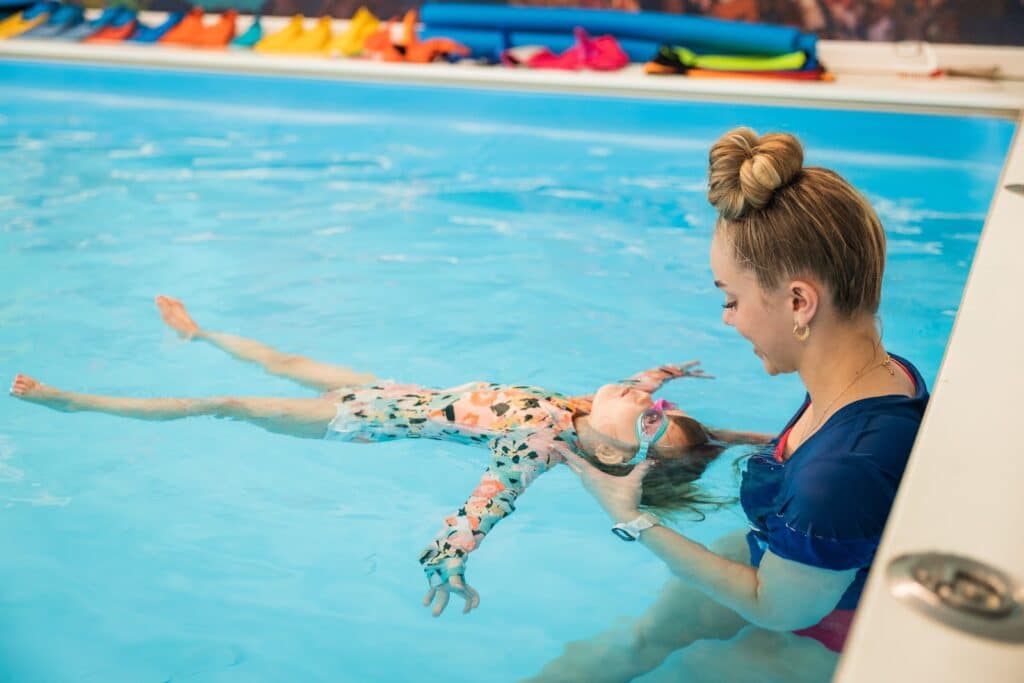Puddle Jumpers 101: Why Not to Use Arm Floaties
What are Puddle Jumpers?
Puddle jumpers have become a popular flotation device for children when swimming or playing in the water. However, while they may seem like a convenient way to keep children safe, they can actually be quite dangerous.
Puddle jumpers are essentially flotation devices that are worn on a child’s arms, chest, or both. They are designed to keep a child afloat in the water and prevent them from sinking or drowning. Here are some reasons we don’t recommend using puddle jumpers.

False Sense of Security:
Children who wear puddle jumpers may think that they will always be safe in the water, even if they do not know how to swim. This false sense of security can lead to children seeking out and getting into water unsupervised and without the skills to self rescue. When a child experiences swimming pools without a floatation device, they learn what their body is and is not capable of. This experience helps develop a healthy respect for the water.
Puddle jumpers can also give parents a false sense of security. Parents may think that their child is safe as long as they are wearing a puddle jumper, but this is not always the case. In fact, parents who rely too heavily on puddle jumpers may not be paying enough attention to their child’s behavior in the water.
Puddle jumpers can also be unreliable. If a puddle jumper is not properly secured or is too loose, it can easily slip off a child’s arms or body. This can happen if the puddle jumper is not the right size for the child, or if it is not properly adjusted. In some cases, a puddle jumper can even come apart in the water, which can be very dangerous for a child who is relying on it to stay afloat.
Interfere with Learning to Swim:
Children who use puddle jumpers may not be as motivated to learn how to swim, as they may feel that they do not need to. This can delay a child’s progress in the water and can even make them more fearful of swimming without a flotation device.
Puddle jumpers can restrict a child’s movement in the water. Puddle jumpers are designed to keep a child’s head above water, but they can also make it more difficult for a child to move their arms and legs freely. This can make it harder for a child to learn proper swimming techniques and can actually increase their risk of drowning. The buoyancy of the puddle jumper also prevents children from building the muscle strength and lung capacity needed to swim on their own.
The biggest barrier puddle jumpers impose on learning to swim, is that they force children into an upright position- also known as the drowning position. Children who wear puddle jumpers will default to an upright position in the water rather than the horizontal position that is needed to swim and float. It is especially important not to put your child in flotation devices when they are learning to swim or have learned to swim. This will interfere with their swimming or force them to swim in the incorrect position.
Conclusion:
While puddle jumpers may seem like a convenient way to keep children safe in the water, they can actually be quite dangerous. They can create a false sense of security and interfere with a child’s ability to learn how to swim. If parents want to keep their children safe in the water, they should invest in swimming lessons and always supervise their children closely while they are swimming or playing in the water. Children who are taught to swim at a young age are more likely to be comfortable and confident in the water, which can help keep them safe throughout their lives.
Ready to dive into fun? If you’re in Davis, Salt Lake, or Utah Counties, secure your child’s spot at SwimKids now! Click here to register and make a splash today!